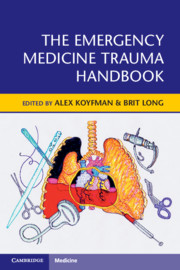Book contents
- The Emergency Medicine Trauma Handbook
- The Emergency Medicine Trauma Handbook
- Copyright page
- Contents
- Contributors
- Preface
- Disclaimer
- Chapter 1 General Approach to Traumatic Injuries
- Chapter 2 Trauma Airway
- Chapter 3 Transfusion in Trauma
- Chapter 4 Trauma in Pregnancy
- Chapter 5 Pediatric Trauma
- Chapter 6 Geriatric Trauma
- Chapter 7 Head Trauma
- Chapter 8 Facial Trauma
- Chapter 9 Eye Trauma
- Chapter 10 Cervical Spine Trauma
- Chapter 11 Thoracolumbar Trauma
- Chapter 12 Neck Trauma
- Chapter 13 Pulmonary Trauma
- Chapter 14 Cardiac Trauma
- Chapter 15 Abdominal and Flank Trauma
- Chapter 16 Genitourinary Trauma
- Chapter 17 Peripheral Vascular Injury
- Chapter 18 Pelvic Trauma
- Chapter 19 Upper Extremity Trauma
- Chapter 20 Lower Extremity Trauma
- Chapter 21 Burns and Electrical Injuries
- Chapter 22 Procedural Sedation and Analgesia in Trauma
- Chapter 23 Commonly Missed Traumatic Injuries
- Index
- References
Chapter 7 - Head Trauma
Published online by Cambridge University Press: 23 August 2019
- The Emergency Medicine Trauma Handbook
- The Emergency Medicine Trauma Handbook
- Copyright page
- Contents
- Contributors
- Preface
- Disclaimer
- Chapter 1 General Approach to Traumatic Injuries
- Chapter 2 Trauma Airway
- Chapter 3 Transfusion in Trauma
- Chapter 4 Trauma in Pregnancy
- Chapter 5 Pediatric Trauma
- Chapter 6 Geriatric Trauma
- Chapter 7 Head Trauma
- Chapter 8 Facial Trauma
- Chapter 9 Eye Trauma
- Chapter 10 Cervical Spine Trauma
- Chapter 11 Thoracolumbar Trauma
- Chapter 12 Neck Trauma
- Chapter 13 Pulmonary Trauma
- Chapter 14 Cardiac Trauma
- Chapter 15 Abdominal and Flank Trauma
- Chapter 16 Genitourinary Trauma
- Chapter 17 Peripheral Vascular Injury
- Chapter 18 Pelvic Trauma
- Chapter 19 Upper Extremity Trauma
- Chapter 20 Lower Extremity Trauma
- Chapter 21 Burns and Electrical Injuries
- Chapter 22 Procedural Sedation and Analgesia in Trauma
- Chapter 23 Commonly Missed Traumatic Injuries
- Index
- References
Summary
Head trauma is a significant cause of death around the world, especially in patients 1–45 years old.1–5 Close to 80% of patients are managed in the emergency department (ED).1.2 Head injury not only causes initial primary injury, but it is associated with several secondary injuries.1–5
- Type
- Chapter
- Information
- The Emergency Medicine Trauma Handbook , pp. 87 - 104Publisher: Cambridge University PressPrint publication year: 2019



